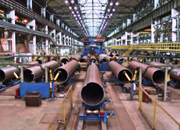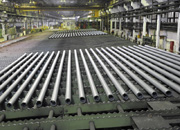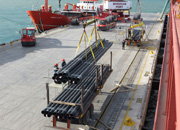09CrCuSb alloy steel pipe is a low-alloy steel material with excellent resistance to sulfuric acid dew point corrosion. It is widely used in flue gas treatment systems in power, chemical, and metallurgical industries. From a material properties perspective, the chemical composition of the 09CrCuSb alloy steel pipe is uniquely designed. The "09" in its name represents a carbon content of approximately 0.09%, "Cr" indicates the presence of chromium, "Cu" represents copper, and "Sb" represents the addition of antimony. This alloy design, through the synergistic effect of multiple elements, forms a dense protective film on the metal surface, effectively blocking the erosion of corrosive media. Specifically, the addition of copper promotes the formation of a stable copper oxide protective layer on the steel surface, while antimony refines the grain size, improving the overall corrosion resistance of the material. Compared to ordinary carbon steel, 09CrCuSb alloy steel pipe exhibits 3-5 times better corrosion resistance and a significantly extended service life in sulfur-containing humid flue gas environments below 60℃.
In terms of manufacturing process, 09CrCuSb alloy steel pipes are manufactured using advanced hot rolling or cold drawing processes. By precisely controlling parameters such as rolling temperature, deformation amount, and cooling rate, ideal mechanical properties and corrosion resistance are ensured. During manufacturing, special attention is paid to the uniformity of chemical composition and the control of impurity content to avoid localized corrosion. Finished steel pipes undergo rigorous non-destructive testing, hydrostatic testing, and dimensional inspection to ensure that each pipe meets the requirements of national standards such as GB/T 5310. Depending on application requirements, this material can be processed into seamless or welded steel pipes of various specifications, with outer diameters typically ranging from 10 to 630 mm and wall thicknesses from 2 to 30 mm.
In terms of application areas, 09CrCuSb alloy steel pipes primarily serve the energy and environmental protection industry. With increasingly stringent environmental regulations, coal-fired power plants must install highly efficient flue gas desulfurization devices, while traditional carbon steel materials are highly susceptible to dew point corrosion in humid, sulfur-containing flue gas. 09CrCuSb alloy steel pipe perfectly solves this problem and is widely used in key components such as flue gas heat exchangers (GGH), chimney inner linings, and desulfurization tower inlet flues. Actual operating data shows that, under the same operating conditions, equipment made with 09CrCuSb alloy steel pipe can have a service life more than three times that of ordinary carbon steel, significantly reducing equipment replacement frequency and maintenance costs. A case study from a large power plant shows that flue components made with this material remained intact after five years of operation, while carbon steel components installed at the same time showed severe corrosion and perforation after only 18 months.
From a technological development perspective, 09CrCuSb alloy steel pipe represents a major breakthrough for my country in the field of corrosion-resistant steel. Through years of research, the R&D team solved the problems of high cost and complex processes associated with traditional sulfuric acid dew point corrosion-resistant steel, developing a cost-effective, domestically produced new material. Compared to similar Japanese products, 09CrCuSb alloy steel pipe maintains similar corrosion resistance while reducing the price by approximately 30%, achieving import substitution. This technology has successively won several national patents and science and technology progress awards and has been included in the National Key New Product Catalog. With in-depth research and development, improved models such as 09CrCuSb-R and 09CrCuSb-N have been developed, further expanding the material's application temperature range and strength grade.
In terms of market performance, 09CrCuSb alloy steel pipe has become the preferred material for domestic power and environmental protection projects. Statistics show that over 80% of newly built coal-fired power plants nationwide use this material in their flue gas treatment systems, with annual demand remaining above 100,000 tons. Besides the power industry, its application in petrochemicals, waste incineration, and steel smelting is also rapidly expanding. Particularly in wet desulfurization system retrofit projects, 09CrCuSb alloy steel pipe, due to its excellent corrosion resistance and economy, is gradually replacing traditional materials such as stainless steel and fiberglass. It is worth mentioning that with the advancement of the "Belt and Road" initiative, this product has been exported to many countries and regions in Southeast Asia and the Middle East, becoming another calling card for "Made in China" in the international market.
From user feedback, the 09CrCuSb alloy steel pipe performs excellently in actual operation. Several power plant technicians stated that after adopting this material, the equipment maintenance cycle has been extended from one year to 3-5 years, significantly reducing unplanned downtime. An equipment manager at a chemical company pointed out that in environments containing complex corrosive media such as SO2 and HCl, the annual corrosion rate of 09CrCuSb alloy steel pipes is only about 0.1 mm, far lower than the industry standard requirement of 0.5 mm/year. These real-world examples fully verify the material's reliability and economy, creating significant value for users.
Regarding maintenance, although 09CrCuSb alloy steel pipes have excellent corrosion resistance, scientific usage guidelines must still be followed. During installation, direct contact with ordinary carbon steel should be avoided to prevent electrochemical corrosion; during operation, the flue gas temperature should be controlled above the dew point to prevent the large-scale generation of condensed acid; during shutdown maintenance, accumulated dust should be removed promptly to keep the surface clean. With proper use, this material can ensure long-term stable operation of equipment and maximize its benefits.
Looking to the future, with increasingly stringent environmental protection requirements and the transformation and upgrading of the energy structure, the market prospects for 09CrCuSb alloy steel pipes remain broad. Research and development will focus on further improving the material's high-temperature corrosion resistance, developing more economical welding processes, and optimizing pipe forming technology. Simultaneously, continuous improvement of material formulations will be a key focus of technological development, particularly for the unique corrosive environments of emerging fields such as biomass power generation and waste incineration. It is foreseeable that this domestically produced high-quality corrosion-resistant material will shine brightly in a wider range of industrial sectors, making a greater contribution to my country's environmental protection and equipment manufacturing industries.
In summary, the 09CrCuSb alloy steel pipe is a model of the integration of materials science and engineering technology in my country. It is not only an effective solution to industrial corrosion problems but also a vivid manifestation of the high-end and specialized development of Chinese manufacturing. With the accumulation of application experience and continuous technological progress, this material will undoubtedly occupy an even more important position in the global industrial corrosion protection field.
 Threeway Steel is known as a professional supplier engaged in manufacturing and distributing a wide range of steel pipe, and our headquarter located the central part of China – Hunan and six associated factories throughout China.
Threeway Steel is known as a professional supplier engaged in manufacturing and distributing a wide range of steel pipe, and our headquarter located the central part of China – Hunan and six associated factories throughout China.
 Threeway Steel is known as a professional supplier engaged in designing, manufacturing and distribution of a wide range of steel products with the headquarter located the central part of China – Hunan and six associated factories throughout China.
Threeway Steel is known as a professional supplier engaged in designing, manufacturing and distribution of a wide range of steel products with the headquarter located the central part of China – Hunan and six associated factories throughout China.
 Threeway Steel is known as a professional supplier engaged in designing, manufacturing and distribution of a wide range of steel products with the headquarter located the central part of China – Hunan and six associated factories throughout China.
Threeway Steel is known as a professional supplier engaged in designing, manufacturing and distribution of a wide range of steel products with the headquarter located the central part of China – Hunan and six associated factories throughout China.
 Threeway Steel is known as a professional supplier engaged in designing, manufacturing and distribution of a wide range of steel products with the headquarter located the central part of China – Hunan and six associated factories throughout China.
Threeway Steel is known as a professional supplier engaged in designing, manufacturing and distribution of a wide range of steel products with the headquarter located the central part of China – Hunan and six associated factories throughout China.
 Threeway Steel is known as a professional supplier engaged in designing, manufacturing and distribution of a wide range of steel products with the headquarter located the central part of China – Hunan and six associated factories throughout China.
Threeway Steel is known as a professional supplier engaged in designing, manufacturing and distribution of a wide range of steel products with the headquarter located the central part of China – Hunan and six associated factories throughout China.

